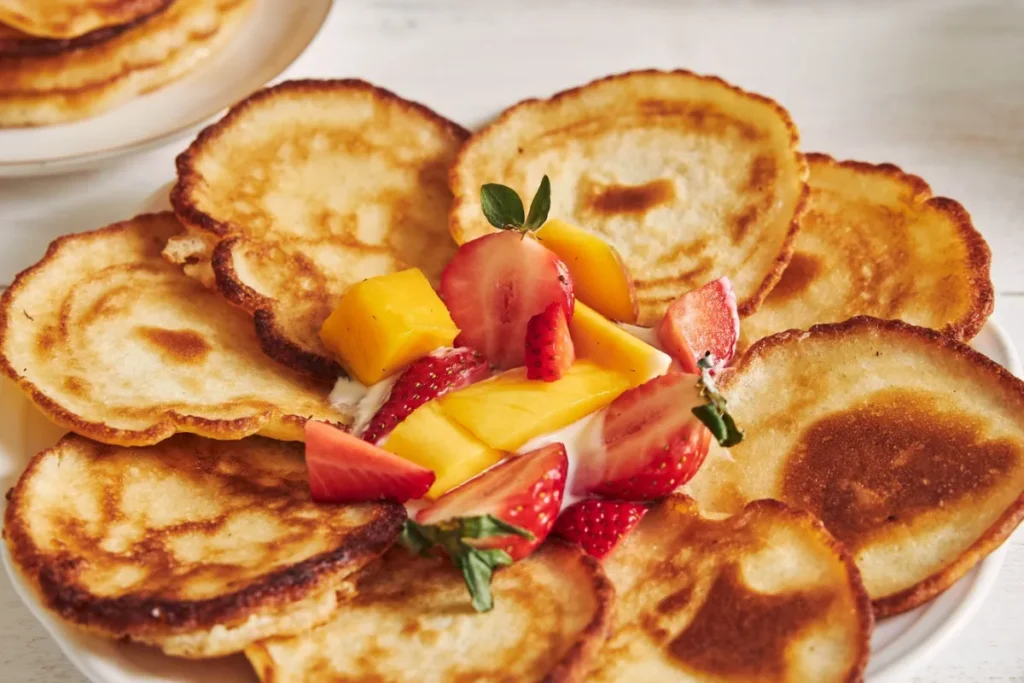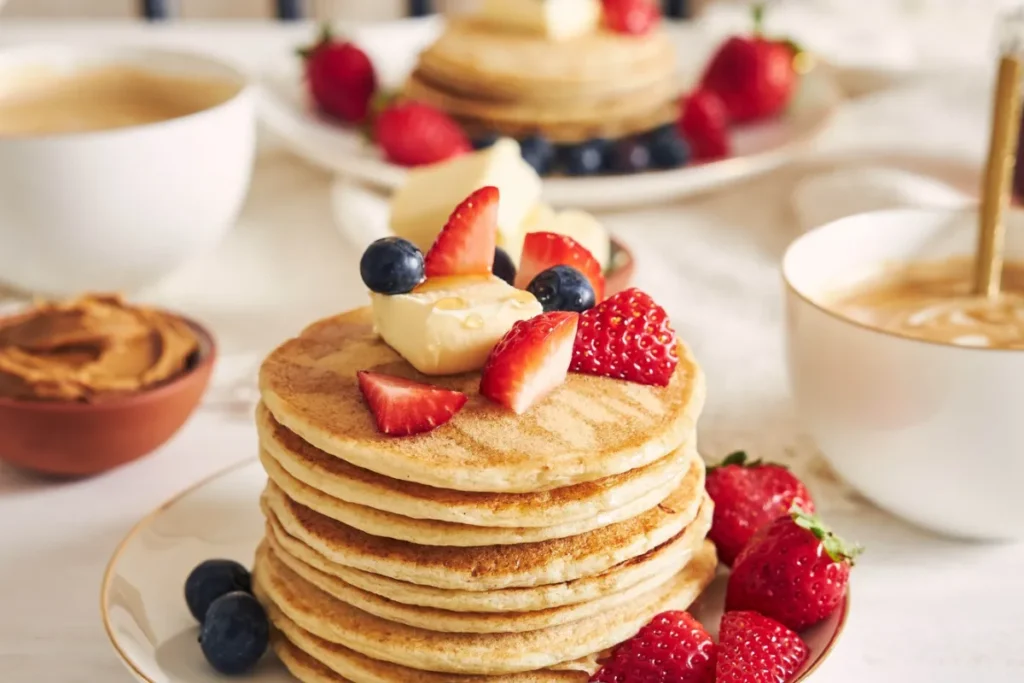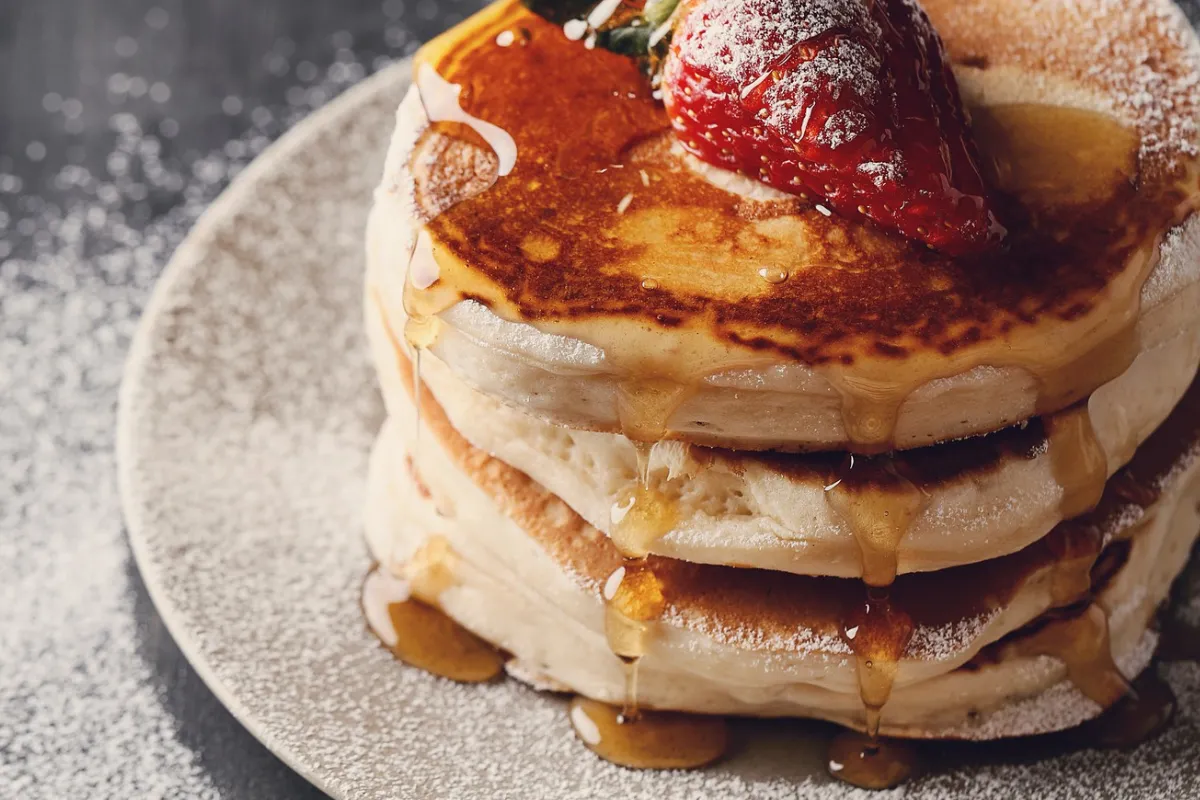Understanding Crepes and English Pancakes
What is the difference between a crepe and an English pancake? . While they may seem similar, there are distinct differences between the two.
Crepes are thin, delicate pancakes that originated in France.You make them from a simple batter of flour, eggs, milk, and butter. You pour the batter onto a hot skillet and swirl it around to create a thin, even layer. You can fill crepes with various sweet or savory fillings, such as Nutella and strawberries or ham and cheese.
On the other hand, English pancakes are thicker and fluffier than crepes. They have a slightly sweeter flavor and are often served with lemon juice and powdered sugar. You make the batter for English pancakes from flour, eggs, milk, and sometimes sugar or vanilla extract.
Both crepes and English pancakes have their own unique textures, flavors, and cooking methods. Whether you prefer the thin elegance of a crepe or the fluffy goodness of an English pancake, both make for a delightful breakfast treat.
Key Differences Between Crepes and English Pancakes
When it comes to crepes and English pancakes, there are a few key differences to note. Firstly, the texture sets them apart – crepes are thin and delicate while English pancakes are thicker and fluffier. This difference in thickness affects the cooking process as well. Crepes are cooked quickly on a hot skillet, while English pancakes require a slightly longer cooking time to ensure they cook through.
Another distinction lies in the ingredients used. Crepes typically consist of a simple batter made from flour, eggs, milk, and butter. In contrast, English pancakes often include sugar or vanilla extract in the batter for added sweetness.
Lastly, the fillings and toppings can vary significantly between the two. Crepes are known for their versatility and can be filled with both sweet and savory options like Nutella with strawberries or ham and cheese. English pancakes, on the other hand, are commonly served with lemon juice and powdered sugar.
In summary, crepes and English pancakes differ in texture, ingredients, and flavor profiles. Ultimately, personal preference will determine which one you prefer.

History and Origins of Crepes and English Pancakes
Crepes and English pancakes have interesting histories that reflect their cultural origins. The origin of crepes can be traced back to Brittany, a region in France, where they were traditionally made using buckwheat flour. Over the years, crepes gained popularity across France and eventually became a beloved dish worldwide.
English pancakes, on the other hand, have roots in the Christian holiday of Shrove Tuesday, also known as Pancake Day. This day marked the last opportunity to use up rich ingredients like eggs and milk before the fasting period of Lent. English pancakes were enjoyed as a way to indulge before the austerity of Lent began.
Both crepes and English pancakes have historical significance and continue to be enjoyed today. Whether it’s the delicate simplicity of crepes or the fluffy comfort of English pancakes, these dishes offer a glimpse into the culinary traditions of their respective cultures.
Ingredients and Texture in What is the difference between a crepe and an English pancake
When it comes to the ingredients, crepes and English pancakes differ in their traditional recipes. Crepes are typically made with simple ingredients like flour, eggs, milk, sugar, and butter. These thin pancakes have a delicate texture and a slightly sweet flavor.
On the other hand, you make English pancakes with similar ingredients such as flour, eggs, milk, and a pinch of salt. However, the batter is typically thicker than that of crepes. This results in fluffy pancakes with a light and airy texture.
In terms of texture, crepes are known for their thinness and flexibility. They can be rolled or folded to hold various fillings like Nutella, berries, or savory options such as ham and cheese. English pancakes are thicker and fluffier, making them ideal for stacking and enjoying with toppings such as lemon juice and sugar or maple syrup.
Regardless of their differences in ingredients and texture, both crepes and English pancakes offer delightful culinary experiences that can be enjoyed in their own unique ways.
Variations in Ingredients Used in Crepes vs. English Pancakes
When it comes to the ingredients, crepes and English pancakes differ in their traditional recipes. Crepes are typically made with simple ingredients like flour, eggs, milk, sugar, and butter. These thin pancakes have a delicate texture and a slightly sweet flavor.
On the other hand, English pancakes are made with similar ingredients such as flour, eggs, milk, and a pinch of salt. However, the batter is typically thicker than that of crepes. This results in fluffy pancakes with a light and airy texture.
Crepes offer more versatility in terms of flavor variations. The addition of vanilla extract or citrus zest can enhance their taste. In contrast, English pancakes are often enjoyed for their simplicity. They rely on the basic ingredients to create a comforting pancake experience.
Whichever option you choose, both crepes and English pancakes can be customized to suit your taste preferences with fillings or toppings. Whether you prefer sweet or savory flavors, there is no shortage of delicious combinations for these beloved pancake treats.
Textural Contrasts: Crepes’ Thinness vs. English Pancakes’ Fluffiness
When it comes to texture, crepes and English pancakes couldn’t be more different. Crepes are known for their thin and delicate nature. The batter is spread thinly across the pan, resulting in a beautifully thin and lacy pancake. This thinness allows the crepe to be light and airy, almost like a delicate sheet of paper.
On the other hand, English pancakes have a completely different texture. The batter used to make English pancakes is thicker, resulting in a fluffy and slightly thicker pancake. These pancakes have a soft and tender bite, with a slight bounce to them.
The contrast in texture between crepes and English pancakes gives them each their own unique appeal. Crepes’ thinness allows for easier rolling and folding, making it perfect for wrapping fillings like fresh fruits or savory ingredients. English pancakes’ fluffiness makes them more substantial and satisfying, with a soft and comforting bite.
In the battle of textures, both crepes and English pancakes offer delightful experiences that cater to different preferences. Whether you prefer the delicate crispness of a crepe or the fluffy tenderness of an English pancake, both will undoubtedly satisfy your pancake cravings.
Cooking Process and Techniques What is the difference between a crepe and an English pancake?
Distinct Cooking Methods for Crepes and English Pancakes
The cooking process for crepes and English pancakes varies significantly.
To make crepes, you pour a thin batter into a hot and lightly greased pan. Then, you swirl the pan to spread the batter evenly
The crepe cooks quickly and is ready to be flipped when the edges start to brown and lift away from the pan. Once flipped, it only needs a few seconds on the other side before being removed from the heat.
On the other hand, you cook English pancakes using a similar method to traditional American pancakes. You pour a thicker batter onto a hot griddle or frying pan with little to no spreading required. The pancake is cooked until bubbles form on the surface, indicating it’s time to flip. It then cooks for another minute or so until golden brown on both sides.
It’s important to note that while crepes require delicate handling, flipping them can be quite tricky due to their thinness. English pancakes offer more forgiveness in this regard.
Tips for Achieving the Perfect Crepe and English Pancake What is the difference between a crepe and an English pancake?
To achieve a perfect crepe, make sure your pan is at the right temperature before pouring in the batter. A medium-high heat works best as it allows for quick cooking without burning the delicate crepe. Additionally, using a non-stick skillet or crepe pan will make flipping easier.
For those making English pancakes, having a well-heated griddle or frying pan is crucial. Preheat your pan on medium heat to ensure even cooking and avoid sticking. Using melted butter or oil to grease the pan before adding the batter can also help prevent sticking.
Both crepes and English pancakes benefit from brief resting periods for their batters. Allowing the batter to rest for approximately 30 minutes before cooking helps both achieve better texture and consistency.
Overall, mastering the cooking methods and techniques specific to each pancake type will ensure you end up with delicious and beautifully cooked crepes or English pancakes.
Distinct Cooking Methods for Crepes and English Pancakes
To achieve the perfect crepe, I make sure that my pan is at the right temperature before pouring in the batter. I heat it on medium-high heat as it allows for quick cooking without burning the delicate crepe. Using a non-stick skillet or crepe pan also makes flipping easier.
For English pancakes, I preheat my griddle or frying pan on medium heat to ensure even cooking and avoid sticking. I usually grease the pan with melted butter or oil before adding the batter to prevent any sticking.
The actual cooking process for crepes and English pancakes differs significantly. To make crepes, I pour a thin batter into a hot and lightly greased pan, then swirl it to spread the batter evenly. The crepe cooks quickly and is ready to be flipped when the edges start to brown and lift away from the pan. Once I flip it, it only needs a few seconds on the other side before being removed from the heat.
For English pancakes, I pour a thicker batter onto a hot griddle or frying pan with little to no spreading required. The pancake is cooked until bubbles form on the surface, indicating it’s time to flip. It then cooks for another minute or so until golden brown on both sides.
In summary, mastering the cooking methods and techniques specific to each pancake type ensures delicious and beautifully cooked crepes or English pancakes.
Tips for Achieving the Perfect Crepe and English Pancake
To achieve the perfect crepe, I make sure that my pan is at the right temperature before pouring in the batter. I heat it on medium-high heat as it allows for quick cooking without burning the delicate crepe. Using a non-stick skillet or crepe pan also makes flipping easier.
For English pancakes, I preheat my griddle or frying pan on medium heat to ensure even cooking and avoid sticking. I usually grease the pan with melted butter or oil before adding the batter to prevent any sticking.
The key to a perfect crepe is to spread a thin layer of batter evenly across the pan. yYou can acheive tilting and swirling the pan as soon as the batter hits it. For English pancakes, it’s important not to spread the batter too thin. You can pour it onto the pan and left to naturally form its shape.
When it comes to flipping, patience is key. Wait until the edges of the crepe start to brown and lift away from the pan before attempting to flip it. For English pancakes, wait until bubbles form on the surface of the pancake before flipping.
Lastly, always use a spatula or pancake turner when flipping both crepes and English pancakes to avoid tearing or breaking them apart.
By following these tips and techniques, you’ll be able to create picture-perfect crepes and fluffy English pancakes every time.

Flavor Profiles and Serving Suggestions
When it comes to flavor profiles, crepes and English pancakes offer a delightful range of options.
You can fill crepes with both sweet and savory fillings, making them versatile.For a sweet twist, fill them with fresh fruits, Nutella, whipped cream, or maple syrup. Savory options include fillings like ham and cheese, spinach and feta, or mushrooms and onions.On the other hand, people typically enjoy English pancakes with sweet toppings such as lemon juice and sugar, golden syrup, or berries. They can also be served with a dollop of clotted cream or jam for an indulgent treat.
People often enjoy both crepes and English pancakes for breakfast or brunch.
Additionally, they make wonderful desserts. Serve them warm with a scoop of ice cream or add a drizzle of chocolate sauce for an extra touch of decadence.
Whether you prefer the delicate flavor of a crepe or the fluffiness of an English pancake, both these delicacies offer endless opportunities for customization and will surely satisfy your taste buds.
Sweet vs. Savory Fillings for Crepes and English Pancakes
When it comes to filling options, both crepes and English pancakes offer a wide range of choices that cater to different taste preferences. Crepes excel in their versatility, as they can be filled with either sweet or savory ingredients. For a sweet twist, I love filling my crepes with a medley of fresh fruits such as strawberries, bananas, or blueberries. Adding a dollop of Nutella or a generous drizzle of maple syrup takes the sweetness to another level.
On the other hand, when I’m in the mood for something savory, crepes are perfect for experimenting with delicious fillings. My personal favorite includes ham and cheese, where the savory ham pairs beautifully with creamy cheeses like Swiss or Gruyere. Another option is a spinach and feta filling that adds a delightful touch of saltiness and richness.
English pancakes lean more towards the sweet side, often served with classic toppings like a squeeze of lemon juice and a sprinkle of sugar. Golden syrup is also a popular choice for those who prefer some extra sweetness.
You can also enjoy these pancakes with fresh berries, providing a burst of fruity flavors.
In summary, while you can fill both crepes and English pancakes with sweet or savory fillings, crepes offer more versatility for experimentation. People tend to enjoy English pancakes with traditional sweet toppings that enhance their delicate flavors.
Traditional Toppings and Accompaniments
When it comes to traditional toppings and accompaniments, both crepes and English pancakes offer a multitude of delicious options. For crepes, classic sweet toppings include a squeeze of fresh lemon juice, a sprinkle of powdered sugar, or a generous dollop of whipped cream. Fillings like Nutella, caramel sauce, or fruit compote are also popular choices to add an extra layer of sweetness.
On the savory side, you can enjoy crepes with fillings such as sautéed mushrooms, creamy chicken and mushroom ragout, or a savory cheese and spinach combination.
For English pancakes, the traditional topping is a simple yet delightful combination of lemon juice and sugar. The tangy citrus flavor pairs perfectly with the pancake’s soft texture. Golden syrup, a thick and sweet syrup made from cane sugar, is another beloved choice that adds a sticky sweetness to every bite.
Whether you prefer sweet or savory, both crepes and English pancakes offer endless opportunities to experiment with different fillings and flavors. From classic combinations to creative twists, these traditional toppings and accompaniments enhance the taste and enjoyment of these delectable treats.
Global Influence and Popularity for What is the difference between a crepe and an English pancake?
Crepes and English pancakes have gained immense popularity around the world, each with their own unique influence and adaptations in different cultures.
Crepes, with their French origins, have become an international favorite. In France, creperies are widely popular and serve a variety of sweet and savory crepes. They have also found their way into various other cuisines, such as the Japanese okonomiyaki and the Indian dosa.
English pancakes have also made their mark globally. In the United Kingdom, pancakes are a staple during Pancake Day or Shrove Tuesday.
People enjoy them with lemon and sugar toppings. In North America, fluffy American-style pancakes have become a beloved breakfast option.
Cafes and restaurants worldwide offer both crepes and English pancakes, catering to diverse palates.
Their versatility allows for endless possibilities when it comes to fillings and flavors, making them a crowd-pleaser for people all over the world.
Cultural Significance of Crepes and English Pancakes Worldwide
Crepes and English pancakes hold cultural significance worldwide, each with unique traditions and customs. In France, crepes are an essential part of French culture, enjoyed on Candlemas Day, a religious holiday marking the end of Christmas festivities.
People believe that flipping the crepe with your right hand while holding a coin in your left hand brings prosperity for the year ahead
Similarly, in the United Kingdom, people link English pancakes to Shrove Tuesday, also known as Pancake Day. This day signifies the beginning of Lent, and people make pancakes to use up rich foods like eggs and milk before a period of fasting. Pancake races are held across the country, where participants race while flipping pancakes in a frying pan.
These traditions highlight how crepes and English pancakes have become embedded in local cultures, symbolizing celebrations and bringing communities together. They add joy and flavor to special occasions, making them an integral part of global culinary heritage.
